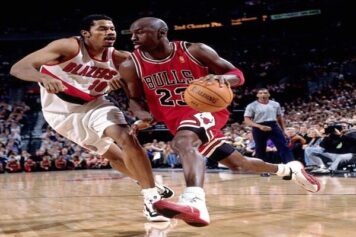The Warhawks’ assistant coach wasn’t just up their free style dancing and shaking his rump to show off his skills before a game. He was “stepping.” To a brother watching, it was proof that the coach was cultured, educated and a member of a deep, rich and prestigious history of black Greek fraternities.
The art of “stepping” was created by African-American fraternities in the 1970s. Though stepping may be performed by an individual, it is generally performed by groups of three or more, often in ill-arrangements that resemble military formations combined with a wild version of the Charleston.
Multiple participants congregate in a decided formation and are started off by a leader, sometimes called the step master, who chants to set off the step. Stepping is a percussive dance in which the entire participant’s body becomes an instrument to produce various rhythms and sounds through the simultaneous use of foot-stomps, spoken word and complex hand claps.
It draws from elements of hip-hop, gymnastics, tap and African and Caribbean dance. Some forms of stepping include the use of props, such as canes, rhythm sticks and elaborate outfits.
The tradition of stepping is rooted within the competitive campus song and dance rituals practiced by historically African American fraternities and sororities, beginning in the mid-1900s.
A 2008 article in voices.yahoo.com on the history of black fraternities and sororities broke down a few of those signature moves and which fraternity the move belongs too. As noted, (some of these are descriptive names, not exact or sanctioned by the organization):
The Nut Cracker: Unique to Phi Beta Sigma Fraternity, Incorporated. A movement where the participant stomps twice, and then brings his hands up high in the air for a moment, claps above the head, and then claps behind the back while stepping twice again. The participant then stomps four times while bringing his clasped fists down slowly at his side.
The Dove (Flapping it's Wings) : Unique to Zeta Phi Beta Sorority Incorporated, where participants cross their arms out in front of them and then "flap" their hands up to meet the back of the other hand, to represent the movement of a dove flapping it's wings.
The "Q" Hop : An energetic trademark movement created by Omega Psi Phi Fraternity, Incorporated where members jump high in the air, hop on one foot, pump their fists, clap, chant and turn their hands outward like Dwayne on “What’s Happening, ” when he said, “Hey, hey, hey.”
The “Q” Hop is what the Warhawks’ assistant coach was doing. We’ve seen basketball player Shaquille O’Neal (who pledged Omega Psi Phi while at LSU) throw his hands up executing the motions of that particular fraternal movement after dunks and dazzling plays. He actually got accused of throwing up gang signs once, because certain media outlets didn’t comprehend the positive cultural significance of his actions.
Ray Lewis’ pregame dance is part of NFL lore, but rarely has it been credited with what it was. The “white” perspective is that Lewis sure knows how to cut up some turf. In reality, Lewis was executing his NFL version of the “Q”-hop and paying homage to the many great black men of his fraternity, who preceded him. If you aren’t a “Q”, you really aren’t supposed to be doing the dance.
Understanding Historically Black Colleges and its fraternities, is essential to grasping the importance of stepping
The first African-American fraternity was developed in December of 1906 under the name Alpha Phi Alpha Fraternity, Incorporated. Back in the rotten days of segregation, African-Americans in college were excluded from membership into historically white organizations.
Thereafter, many other African-American fraternity and sororities were established, driven by the belief that being a member of a fraternity or sorority is deeper than complexion, class, or social status. Though some original black sororities practiced discrimination towards dark-skinned blacks (as highlighted in Spike Lee’s classic movie, School Daze), eventually fraternities and sororities became necessary, all-inclusive entities).
Out of this desire to have Greek organizations of their own and build business and social networks with other black college students across the country, the black fraternities and sororities became brother and sisterhoods, which positively galvanized the African-American campus communities, created a sense of historical pride, and set up partnerships and friendships across the world. These deep, cultural unions have empowered educated blacks in this country for decades.
The most influential African-Americans in history, from Martin Luther King to Thurgood Marshall to Jada Pinckett-Smith to ex-Presidential candidate Jesse Jackson, are black Greeks. There are currently nine black fraternal organizations officially recognized by the National Pan-Hellenic Council, also known as the "Divine Nine.
Most historians agree that Phi Beta Sigma Fraternity, Incorporated, and then Omega Psi Phi Fraternity, Incorporated, were the first to spark the stepping craze, which now stands alone as the most exciting event in the black college experience. College students pack pro stadiums to see the annual “step-offs” between competing black Greek organizations from all over the country. There have been movies, videos and documentaries dedicated to celebrating and enlightening people about the art of stepping and its historical significance.
Nowadays, popular dance movies like Stomp the Yard and How She Move have incorporated stepping into dance competitions. Some moves are copied to the letter and used liberally, but it’s well known in black fraternal social circles, that certain steps and movements are unique to particular organizations.
To Rohrbach's credit, he did make a Stomp The Yard movie reference, so he does at least recognize the basic elements of stepping– even if he does mistake it for simple dancing. No offense to mainstream media outlets' "epic" description of the assistant coach's dance, because he was killing it out there.
But what was described by white media as pure entertainment, has a meaning that transcends sports. That has to be recognized and accurately reported. Too often, inaccurate interpretations of black history are offered by people outside of the race, with no true cultural comprehension of what the heck is going on inside the cipher. It also speaks to the indisputable need to have black voices speaking on black subjects in media, in order to avoid misinformation.



